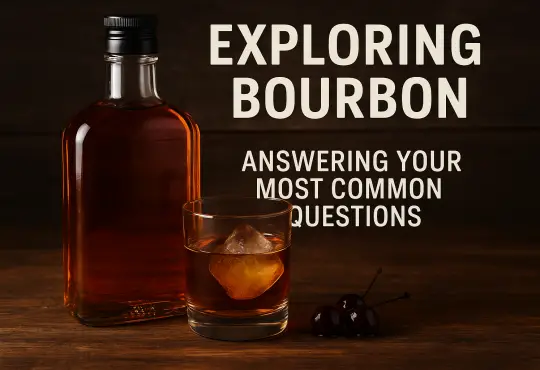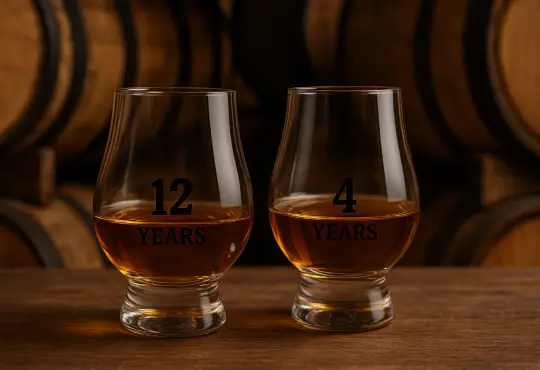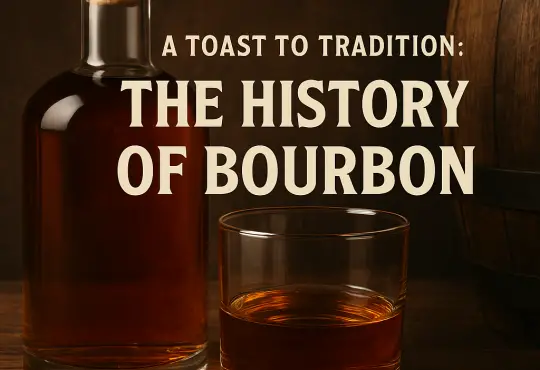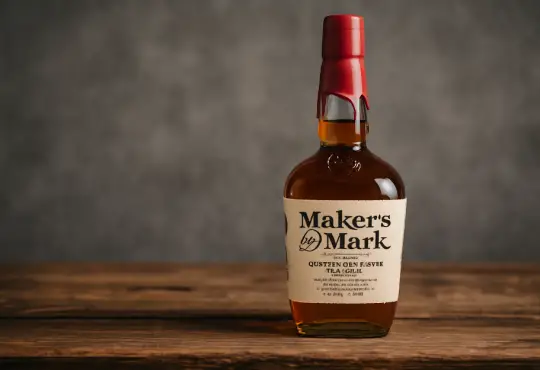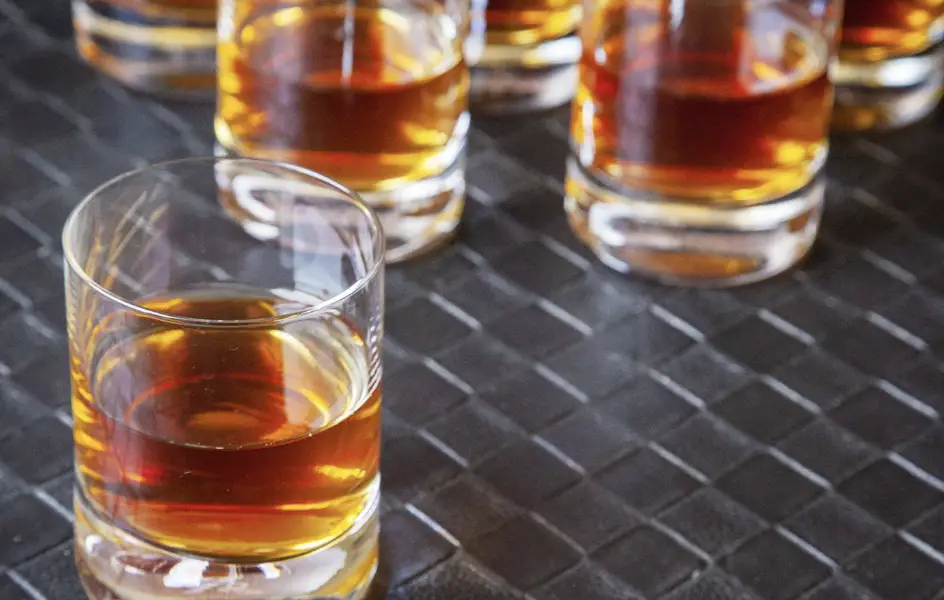
Bourbon Appreciation 101: A Beginner’s Guide to Enjoying the World of Bourbon
Welcome to the world of bourbon! Whether you’re a whiskey enthusiast or someone who wants to explore new flavors, this training manual is designed to introduce you to the art of enjoying bourbon. In this informal guide, we’ll take you through the basics of bourbon, from understanding its origins to appreciating its unique flavors. So, grab a glass and let’s dive into the wonderful world of bourbon!
Chapter 1: Bourbon Basics
1.1 Definition and Origins Bourbon is a distinct type of whiskey that holds a special place in American spirits. To be legally classified as bourbon, the spirit must meet certain criteria established by the U.S. government. The origins of bourbon can be traced back to the late 18th century in Kentucky, although its production has expanded to other regions over time.
1.2 The Key Ingredients Bourbon is primarily made from four key ingredients: corn, rye, barley, and water. However, the dominant grain used in bourbon production is corn, which sets it apart from other types of whiskey. According to legal requirements, bourbon must be made from a mash bill that contains a minimum of 51% corn. The remaining percentage is usually a combination of rye, barley, and sometimes wheat.
1.3 The Distillation Process Bourbon undergoes a process of distillation, where the mash is fermented and then distilled to extract the alcohol. The distillation process separates the alcohol from the other components of the mash, resulting in a liquid with a higher alcohol content.
1.4 Aging in Charred Oak Barrels One of the defining characteristics of bourbon is its aging process. After distillation, bourbon is aged in new, charred oak barrels. The use of charred barrels imparts distinct flavors, colors, and aromas to the spirit. The aging period can vary, but to be legally called straight bourbon, it must be aged for a minimum of two years.
1.5 Legal Requirements for Bourbon To be legally recognized as bourbon, the spirit must meet specific criteria as defined by the U.S. government. These requirements include:
- Must be produced in the United States.
- Must be made from a mash bill containing at least 51% corn.
- Must be distilled to no more than 160 proof (80% alcohol by volume).
- Must be aged in new, charred oak barrels.
- Must be entered into the barrel for aging at no more than 125 proof (62.5% alcohol by volume).
- Must be bottled at a minimum of 80 proof (40% alcohol by volume).
1.6 Bourbon vs. Whiskey: Understanding the Difference While all bourbons are whiskeys, not all whiskeys are bourbons. The key distinction lies in the specific requirements bourbon must meet to be classified as such. Whiskey is a broader category that encompasses various styles, including bourbon, rye, scotch, and more.
1.7 Bourbon’s Flavor Profile Bourbon offers a wide range of flavors and aromas. Common tasting notes include caramel, vanilla, oak, spice, and sometimes fruity or nutty undertones. The flavors can vary based on factors such as the mash bill, yeast strains, distillation process, aging conditions, and blending techniques employed by different distilleries.
1.8 Popular Bourbon Brands The bourbon market is filled with numerous reputable and well-established brands. Some of the popular bourbon brands include:
- Jim Beam
- Maker’s Mark
- Wild Turkey
- Buffalo Trace
- Woodford Reserve
- Four Roses
- Knob Creek
- Elijah Craig
- Pappy Van Winkle (highly sought after and limited availability)
Chapter 2: Tasting Bourbon Like a Pro
2.1 Preparing for a Tasting Session Tasting bourbon is not just about taking a sip; it’s an experience that engages multiple senses. To fully appreciate and evaluate bourbon, it’s important to prepare for a tasting session properly:
- Choose a calm and quiet environment free from strong odors that may interfere with the aromas of the bourbon.
- Use clean, tulip-shaped or Glencairn glasses that concentrate the aromas and allow for swirling.
- Have a water glass and a pitcher of room-temperature water available for sipping and dilution.
- Consider having unsalted crackers or bread nearby to cleanse your palate between samples.
2.2 The Art of Observing: Color, Clarity, and Legs Begin by visually examining the bourbon in your glass. Pay attention to the following aspects:
- Color: Observe the bourbon’s hue, which can range from pale straw to deep amber. The color is influenced by the aging process and the interaction with the oak barrel.
- Clarity: Look for clarity and absence of sediment or particles in the liquid.
- Legs (or tears): Swirl the bourbon gently and observe how it clings to the sides of the glass before slowly dripping back down. The legs can indicate the bourbon’s viscosity and alcohol content.
2.3 Unleashing the Aromas: The Nose of Bourbon The aroma of bourbon is a vital component of the tasting experience. To fully explore the nose of bourbon:
- Bring the glass to your nose and take a gentle sniff, keeping your mouth slightly open.
- Note the initial impressions: Is it sweet, fruity, floral, spicy, or woody?
- Take deeper sniffs to explore the layers of aromas: caramel, vanilla, oak, baking spices, fruits, or other complex notes.
- Try to identify specific scents, but don’t worry if you can’t pinpoint them all. Each person’s sense of smell is unique.
2.4 Savoring the Flavors: The Palate of Bourbon Now comes the moment to taste the bourbon and experience its flavors:
- Take a small sip and let it coat your entire palate, allowing the flavors to unfold.
- Pay attention to the initial taste, the development on the palate, and the lingering finish.
- Notice the balance of sweetness, bitterness, and spiciness.
- Identify the primary flavors and their intensity. Is it more caramel-forward, with hints of dark chocolate or fruitiness?
- Consider the complexity of the bourbon—how the flavors evolve and interact with each other.
2.5 Evaluating the Finish: Length and Complexity The finish refers to the sensations and flavors that linger after swallowing the bourbon. Consider the following aspects:
- Length: Notice how long the flavors persist on your palate. A longer finish indicates a more robust and lingering taste experience.
- Complexity: Assess the depth and layers of flavors that emerge during the finish. Does it evolve and offer new nuances or remain consistent?
2.6 Taking Notes and Developing a Personal Tasting Vocabulary To enhance your bourbon tasting journey, it’s beneficial to develop a personal tasting vocabulary and take notes:
- Document your observations, including color, aroma, flavors, and finish.
- Use descriptive terms to express your impressions, such as sweet, spicy, smoky, or nutty.
- Over time, your tasting notes will serve as a valuable reference to compare and recall your experiences with different bourbons.
Chapter 3: Exploring Bourbon Brands and Styles
3.1 Entry-Level Bourbons for Beginners If you’re new to bourbon, it’s wise to start with entry-level options that are more approachable in terms of taste and price. These bourbons provide a solid introduction to the flavors and characteristics of the spirit. Some recommended entry-level bourbons include:
- Evan Williams
- Four Roses Yellow Label
- Bulleit Bourbon
- Old Forester
3.2 Popular Bourbon Brands and Their Distinctive Characteristics The world of bourbon is filled with a wide array of brands, each with its own unique characteristics. Exploring different brands allows you to discover your personal preferences. Here are some popular bourbon brands and their distinctive qualities:
- Jim Beam: Known for its smooth and approachable flavor profile with subtle vanilla and caramel notes.
- Maker’s Mark: Recognized by its signature red wax-dipped bottles, it offers a rich, sweet, and mellow taste.
- Wild Turkey: Famous for its robust and bold flavor, featuring a high rye content and notes of spice.
- Buffalo Trace: Renowned for its well-balanced flavor profile, with hints of caramel, vanilla, and a touch of spice.
- Woodford Reserve: Loved for its complex and sophisticated character, combining rich flavors of oak, dark fruit, and spice.
- Four Roses: Offers a diverse range of bourbons with different mash bills and yeast strains, resulting in varying flavor profiles.
3.3 Understanding Single Barrel and Small Batch Bourbons Single barrel and small batch bourbons are terms that denote specific production methods and result in unique flavor profiles:
- Single Barrel: These bourbons are sourced from a single barrel, ensuring distinct flavors that may vary from barrel to barrel. They often showcase more pronounced and nuanced characteristics.
- Small Batch: Small batch bourbons are crafted by combining select barrels to create a consistent flavor profile. The blending process adds complexity and balance to the final product.
3.4 Bourbon Regions: Kentucky and Beyond While bourbon has deep roots in Kentucky, it’s worth exploring bourbons from other regions as well. Some notable regions producing quality bourbon beyond Kentucky include:
- Tennessee: Known for its unique charcoal filtering process, Tennessee produces notable brands like Jack Daniel’s and George Dickel.
- Indiana: Distilleries in Indiana, such as MGP, have gained recognition for supplying bourbon to various brands, showcasing their expertise in the production process.
- Texas: Texas bourbon distilleries are emerging with their hot climate influencing the aging process, resulting in accelerated maturation and bold flavors.
3.5 Limited Edition and Special Release Bourbons Bourbon enthusiasts eagerly anticipate limited edition and special release bottlings that offer unique expressions and limited availability. These releases often showcase experimental aging techniques, rare mash bills, or distinct flavor profiles. Examples of sought-after limited editions include:
- Pappy Van Winkle: Produced in limited quantities, Pappy Van Winkle bourbons are highly regarded for their exceptional quality and complexity.
- Buffalo Trace Antique Collection: Released annually, this collection includes highly acclaimed limited editions like George T. Stagg, William Larue Weller, and Thomas H. Handy.
- Various Distillery Exclusive Bottlings: Distilleries often release special editions exclusively available at their visitor centers, providing an opportunity to taste unique expressions not found in regular retail distribution.
Chapter 4: Perfecting the Bourbon Experience
4.1 Choosing the Right Glassware The glassware you use can significantly enhance your bourbon-drinking experience. Consider using the following types of glasses:
- Tulip-shaped or Glencairn glasses: These glasses are ideal for bourbon tasting. They have a wide bowl that narrows towards the top, concentrating the aromas and allowing you to swirl the bourbon gently without spilling.
- Copita glasses: Similar to tulip-shaped glasses, copita glasses have a tulip-like shape but with a longer stem. They are often used for nosing and sipping bourbon, as the long stem prevents the heat of your hand from affecting the temperature of the bourbon.
- Old-fashioned glasses: These short, wide glasses with a thick base are commonly used for serving bourbon on the rocks or in cocktails. While they may not offer the same aroma concentration as tulip-shaped glasses, they are suitable for casual bourbon enjoyment.
4.2 Proper Bourbon Tasting Techniques To fully appreciate the flavors and aromas of bourbon, it’s important to employ proper tasting techniques:
- Sight: Hold the glass up to the light and observe the bourbon’s color, clarity, and viscosity. Take note of any sediment or legs that form when you swirl the bourbon gently.
- Smell: Bring the glass to your nose and take a series of short, gentle sniffs with your mouth slightly open. Pay attention to the different aromas that emerge, such as caramel, vanilla, oak, spices, or fruity notes. Try to identify specific scents and note their intensity.
- Taste: Take a small sip and let the bourbon coat your entire palate. Allow the flavors to unfold, paying attention to the initial taste, the development on the palate, and the finish. Take note of the balance of flavors, sweetness, bitterness, and spiciness. Consider the complexity of the bourbon and how the flavors evolve and interact with each other.
- Mouthfeel: Pay attention to the texture and body of the bourbon. Is it light and smooth, or rich and full-bodied? Notice the level of alcohol heat and how it contributes to the overall experience.
- Finish: Evaluate the lingering flavors and sensations that remain after swallowing the bourbon. Consider the length of the finish and any additional flavors or complexities that emerge.
4.3 Pairing Bourbon with Food Bourbon can complement and enhance the flavors of certain foods. Consider the following pairing suggestions:
- Cheese: Pair a rich, caramel-forward bourbon with aged cheddar or blue cheese. The complexity of the bourbon will complement the bold flavors of the cheese.
- Chocolate: Match a sweeter bourbon with dark chocolate or chocolate desserts. Look for bourbons with notes of caramel, toffee, or dark fruits to complement the chocolate flavors.
- Grilled Meats: Pair a smoky or spicy bourbon with grilled meats like steak or barbecue. The bourbon’s robust flavors will stand up well to the bold flavors of the meat.
- Nuts: Enjoy a nutty bourbon alongside a selection of mixed nuts. The bourbon’s warmth and nutty undertones will create a harmonious pairing.
4.4 Bourbon Cocktails Bourbon is a versatile spirit that can be used to create a wide variety of delicious cocktails. Here are a few classic bourbon-based cocktails to explore:
- Old Fashioned: A timeless cocktail made with bourbon, sugar, bitters, and an orange twist. It’s a simple yet flavorful way to enjoy bourbon’s rich flavors.
- Mint Julep: A refreshing cocktail traditionally made with bourbon, fresh mint, sugar, and crushed ice. It’s a popular choice during the Kentucky Derby and perfect for hot summer days.
- Manhattan: A sophisticated cocktail made with bourbon, sweet vermouth, and bitters. Garnish with a cherry for an added touch of sweetness.
- Bourbon Sour: A tangy and refreshing cocktail made with bourbon, lemon juice, and simple syrup. It can be served on the rocks or strained into a chilled glass.
4.5 Storing and Serving Bourbon Proper storage and serving techniques can ensure that your bourbon remains enjoyable over time:
- Storage: Keep your bourbon in a cool, dark place, away from direct sunlight and extreme temperature fluctuations. The bottle should be tightly sealed to prevent oxidation.
- Serving Temperature: Most bourbons are best served at room temperature or slightly chilled. If you prefer your bourbon chilled, use a single large ice cube or whiskey stones to avoid dilution.
- Water and Ice: Some people prefer to add a small splash of water or an ice cube to their bourbon to mellow the flavors or lower the temperature. Experiment to find your preferred level of dilution.
- Proper Pouring: When pouring bourbon, aim for a standard serving size of 1.5 to 2 ounces. This allows you to fully appreciate the flavors without overwhelming your palate.
Chapter 5: Deepening Your Bourbon Knowledge
5.1 Bourbon Production Process Understanding the bourbon production process is essential for deepening your knowledge of this beloved spirit. The key steps involved are:
- Mash Bill: Bourbon must be made from a grain mixture that is at least 51% corn. The remaining grains typically include malted barley, rye, or wheat. The mash bill plays a significant role in the flavor profile of the bourbon.
- Mashing: The grains are ground and mixed with water to create a mash. Enzymes convert the starches in the grains into fermentable sugars.
- Fermentation: Yeast is added to the mash, and fermentation occurs, converting the sugars into alcohol. This process typically takes a few days and creates a low-alcohol liquid known as “distiller’s beer.”
- Distillation: Distillation involves heating the distiller’s beer in a still. As the liquid evaporates, it travels through the still and condenses, resulting in a higher-alcohol spirit called “new make” or “white dog.”
- Aging: The new make is placed in charred oak barrels for aging. By law, bourbon must be aged in new, charred oak containers. Aging allows the bourbon to develop its distinctive flavors and characteristics as it interacts with the wood.
- Bottling: After aging, bourbon is typically filtered and diluted to the desired proof using water. It is then bottled, ready for distribution and enjoyment.
5.2 Understanding Bourbon Labels and Terminology Bourbon labels can provide valuable information about the spirit. Familiarize yourself with the following terms and labels to deepen your bourbon knowledge:
- Age Statement: Some bourbons feature an age statement on the label, indicating the number of years the bourbon has been aged. Remember that the age statement reflects the youngest whiskey in the bottle.
- Bottled-in-Bond (BiB): This label signifies that the bourbon meets specific legal requirements, including being produced in a single distillation season, aged for at least four years, and bottled at 100 proof (50% alcohol by volume). BiB bourbons are known for their quality and consistency.
- Small Batch: Small batch bourbons are produced by combining a limited number of barrels, resulting in a more limited and often higher-quality release.
- Barrel Proof/Cask Strength: These bourbons are bottled directly from the barrel without dilution, allowing you to experience the full intensity of flavors and higher alcohol content.
- Single Barrel: Single barrel bourbons are sourced from a single barrel, offering unique and distinct flavor profiles. Each bottle represents the characteristics of a specific barrel.
5.3 Bourbon Heritage and Distillery Visits Immerse yourself in the rich heritage of bourbon by visiting distilleries and learning about their unique production processes. Consider the following aspects:
- Kentucky Bourbon Trail: Plan a trip along the renowned Kentucky Bourbon Trail, which includes major distilleries such as Jim Beam, Maker’s Mark, and Woodford Reserve. This trail provides insights into the history, traditions, and craftsmanship of bourbon production.
- Distillery Tours: Take advantage of guided tours offered by distilleries to learn about their specific production methods and gain a deeper understanding of bourbon-making. These tours often include tastings and the opportunity to see the aging warehouses.
- Tasting Experiences: Participate in bourbon tastings offered by distilleries or specialized whiskey bars. These experiences provide the opportunity to sample different expressions, learn about flavor profiles, and develop your palate.
5.4 Resources for Further Exploration To deepen your bourbon knowledge, utilize various resources that provide valuable information and insights:
- Books: Expand your understanding of bourbon through educational books written by industry experts and bourbon enthusiasts. Some recommended titles include “Bourbon Curious” by Fred Minnick and “Tasting Whiskey” by Lew Bryson.
- Online Communities: Join bourbon-focused online communities and forums to engage with fellow enthusiasts, share experiences, and seek recommendations. Websites like Reddit’s r/bourbon and bourbon-focused Facebook groups are great places to connect with like-minded individuals.
- Whiskey Events: Attend whiskey events, tastings, and festivals in your area to discover new brands, meet distillers, and further explore the world of bourbon.
- Bourbon Magazines and Websites: Stay updated on the latest bourbon news, reviews, and industry developments by subscribing to reputable bourbon magazines or visiting well-curated bourbon websites.
Chapter 6: Bourbon Appreciation Events and Distillery Visits
6.1 Bourbon Tastings and Whiskey Events Bourbon appreciation events and tastings provide unique opportunities to expand your knowledge, explore different brands, and connect with fellow bourbon enthusiasts. Consider the following types of events:
- Whiskey Festivals: Attend whiskey festivals that feature a wide range of bourbon brands, distilleries, and master distillers. These events often include tastings, seminars, and educational sessions to enhance your bourbon appreciation.
- Tasting Flights: Participate in organized tasting flights at bars, restaurants, or whiskey establishments. These curated flights offer the chance to sample multiple bourbons side by side, allowing you to compare flavors, aromas, and styles.
- Bourbon Dinners and Pairing Events: Explore bourbon dinners or pairing events where expertly crafted menus are designed to complement and highlight the flavors of different bourbons. These events often feature collaborations between chefs and distilleries to create unforgettable dining experiences.
- Masterclasses and Workshops: Attend masterclasses and workshops conducted by industry experts or master distillers. These sessions delve deep into bourbon production, tasting techniques, and the nuances of specific brands, offering invaluable insights into the world of bourbon.
6.2 Distillery Visits and Tours Visiting distilleries provides a firsthand experience of the bourbon-making process and allows you to immerse yourself in the history and craftsmanship behind your favorite spirits. Here’s what to consider when planning a distillery visit:
- Research Distilleries: Choose distilleries that align with your interests and bourbon preferences. Consider factors such as their history, reputation, production methods, and availability of tours or tastings.
- Distillery Tours: Most distilleries offer guided tours that take you through the production facilities, aging warehouses, and bottling areas. These tours provide insights into the distilling process, barrel aging, and the unique characteristics of each distillery’s bourbon.
- Tastings: Distillery tours often include tasting sessions where you can sample a variety of their bourbons. Take note of the flavor profiles, aging techniques, and any special releases or distillery-exclusive bottlings available for tasting.
- Interaction with Distillers and Staff: Distillery visits offer the opportunity to interact with master distillers, brand ambassadors, and knowledgeable staff members. Don’t hesitate to ask questions, seek recommendations, and engage in conversations about bourbon production and the distillery’s history.
- Distillery Exclusive Bottlings: Some distilleries offer exclusive bottlings that are only available for purchase at their visitor centers. These limited-edition releases provide a chance to taste unique expressions and add to your bourbon collection.
- Souvenirs and Merchandise: Distillery gift shops often offer a range of bourbon-related merchandise, including glassware, apparel, and collectible items. Take the opportunity to browse and select souvenirs that commemorate your distillery visit.
6.3 Responsible Bourbon Appreciation While exploring bourbon appreciation events and distillery visits, it’s important to prioritize responsible consumption and adhere to local laws and regulations. Consider the following guidelines:
- Pace Yourself: Savor and enjoy the flavors of bourbon, but be mindful of your alcohol intake. Bourbon tastings often involve small pours, allowing you to experience a variety of flavors without excessive consumption.
- Designated Driver or Transportation: Arrange for a designated driver or use alternative transportation options like taxis, rideshares, or public transportation when attending bourbon events or visiting distilleries.
- Know Your Limits: Understand your tolerance and know when to stop consuming alcohol. It’s essential to prioritize your safety and the safety of others.
- Stay Hydrated and Snack: Drink water in between tastings to stay hydrated and cleanse your palate. Additionally, having snacks or light food can help to mitigate the effects of alcohol.
Chapter 7: Responsible Bourbon Enjoyment
7.1 Understanding Responsible Consumption Bourbon is meant to be enjoyed responsibly, and it is important to understand the principles of responsible consumption. Follow these guidelines to ensure a safe and enjoyable bourbon experience:
- Moderation: Enjoy bourbon in moderation and be mindful of your alcohol intake. The Centers for Disease Control and Prevention (CDC) defines moderate drinking as up to one drink per day for women and up to two drinks per day for men.
- Know Your Limits: Understand your own tolerance for alcohol and recognize when you’ve had enough. It’s crucial to listen to your body and be aware of the effects of alcohol on your judgment and coordination.
- Legal Drinking Age: Only consume bourbon if you are of legal drinking age in your country or region. It is illegal and unsafe to consume alcohol if you are underage.
- Avoid Drinking and Driving: Never drink and drive. If you plan to consume bourbon, make alternative transportation arrangements such as using a designated driver, calling a taxi or rideshare service, or taking public transportation.
7.2 Responsible Hosting and Socializing When hosting or attending bourbon-related events, it is important to promote responsible behavior and create a safe environment for all participants. Consider the following tips:
- Offer Non-Alcoholic Options: Provide non-alcoholic beverages and ensure there are options available for guests who choose not to consume alcohol or prefer to moderate their intake.
- Encourage Responsible Drinking: Educate your guests about responsible drinking practices and encourage them to pace themselves and drink in moderation. Offer water and snacks to help guests stay hydrated and mitigate the effects of alcohol.
- Be a Responsible Host: As a host, it is your responsibility to monitor your guests’ alcohol consumption and intervene if someone appears intoxicated. Be prepared to provide alternative transportation or arrange for a safe ride home for anyone who is unable to drive.
7.3 Personal Health and Well-being Prioritizing your health and well-being is essential when enjoying bourbon. Consider the following guidelines:
- Stay Hydrated: Drink water between bourbon tastings to stay hydrated and prevent dehydration. Alcohol can deplete your body’s water levels, so it’s important to replenish them.
- Eat Before and During Consumption: Consuming bourbon on a full stomach can help slow the absorption of alcohol into your bloodstream. Consider enjoying a meal or snacks before and during your bourbon experience to mitigate the effects of alcohol.
- Understand Personal Limits: Everyone’s tolerance for alcohol varies, so it’s important to know your own limits. Pay attention to how alcohol affects you personally and be aware of any physical or emotional changes.
- Seek Professional Help if Needed: If you or someone you know is struggling with alcohol consumption or related issues, seek professional help. There are resources available such as counselors, support groups, and helplines that can provide assistance.
7.4 Enjoying Bourbon Responsibly in Social Settings When enjoying bourbon in social settings, it is important to be mindful of responsible behavior and respect the well-being of others. Follow these guidelines:
- Respect Others’ Choices: Be respectful of those who choose not to drink alcohol or who prefer to consume it in moderation. Avoid pressuring others to drink or making them uncomfortable because of their choices.
- Look Out for Others: If you notice someone exhibiting signs of intoxication or distress, intervene and offer assistance. Encourage them to drink water, seek fresh air, or help them arrange a safe way to get home.
- Practice Responsible Gifting: If you choose to give bourbon as a gift, consider the recipient’s preferences and drinking habits. Be mindful of gifting alcohol to individuals who may struggle with alcohol-related issues.
Conclusion
Congratulations! You’ve reached the end of Bourbon Appreciation 101. By now, you should have a solid foundation in the world of bourbon and be equipped to explore different brands, styles, and serving techniques. Remember to continue learning, experimenting, and enjoying bourbon responsibly. So, raise your glass, savor the flavors, and embark on a lifelong journey of bourbon appreciation. Cheers!

